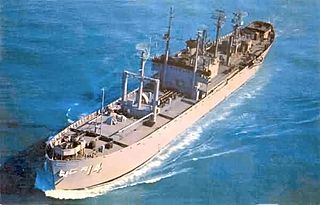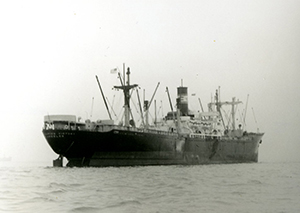
The Victory ship was a class of cargo ship produced in large numbers by American shipyards during World War II to replace losses caused by German submarines. They were a more modern design compared to the earlier Liberty ship, were slightly larger and had more powerful steam turbine engines, giving higher speed to allow participation in high-speed convoys and make them more difficult targets for German U-boats. A total of 531 Victory ships were built in between 1944 and 1946.

USS Betelgeuse (AK-260) was the last of the cargo ships in service in the United States Navy. On 10 April 1944, it was renamed the SS Colombia Victory after being launched as a Victory ship to carry cargo during World War II. She was transferred to the US Navy in 1951.

USNS Bowditch (T-AGS-21) was the lead ship of her class of oceanographic survey ships for the United States Navy. Launched as the SS South Bend Victory in 1945, Maritime Commission hull number MCV 694, a type VC2-S-AP3 Victory ship, she was named for Nathaniel Bowditch, the second U.S. Navy vessel named in his honor. The ship was acquired by the Navy in August 1957 and converted to an AGS at Charleston Naval Shipyard. Named Bowditch on 8 August 1957 and placed in service 8 October 1958 for operation by the Military Sea Transportation Service (MSTS).

USS Interpreter (AGR-14) was a Guardian-class radar picket ship, converted from a Liberty Ship, acquired by the US Navy in 1957. She was reconfigured as a radar picket ship and assigned to radar picket duty in the North Pacific Ocean as part of the Distant Early Warning Line.

USS Boulder Victory (AK-227) was a Boulder Victory-class cargo ship acquired by the US Navy during World War II. She was the lead ship of 20 ships in her class. She carried ammunition into the Pacific Ocean war zone and, on 20 December 1944 at Manus Island, New Guinea, she struck a naval mine and suffered a very large hole in her side.

The SS Lindenwood Victory was a Victory-class cargo ship built during World War II. The Lindenwood Victory was a type VC2-S-AP2 victory ship built by Permanente Metals Corporation, Yard 2, of Richmond, California. The Maritime Administration cargo ship was the 766th ship built. Her keel was laid on May 12, 1945. SS Lindenwood Victory was an armed cargo ship She was built in just 70 days, under the Emergency Shipbuilding program for World War II. SS Lindenwood Victory was an armed cargo ship, named for Lindenwood University in St. Charles, Missouri, one of 150 educational institutions that had Victory ships named after them. The 10,600-ton ship was constructed for the Maritime Commission.

SS Mercer Victory was a Boulder Victory-class cargo ship built for World War II. Mercer Victory, a Victory ship, was launched 14 March 1945 by Permanente Metals Corporation, Richmond, California and operated by the States Marine Line. At the ceremonial ship launching, Mercer University President Spright Dowell said the SS Mercer Victory should strive: “to do her full-part for the national defense” and “to study a plan for after war conditions and needs.”

USS Alcor, AK-259, was a Greenville Victory-class cargo ship in service with the United States Navy from 1952 to 1968. She was originally built in 1944 as SS Rockland Victory, a World War II era Victory ship. She was sold for scrap in 1970.

The SS Carroll Victory was the twenty-seventh Victory ship built during the World War II under the Emergency Shipbuilding program. shewas launched by the California Shipbuilding Company on June 13, 1944, and completed on August 31, 1944. The ship was named after Carroll, Iowa. The ship’s United States Maritime Commission designation was VC2-S-AP3 with a hull number 27 (V-27). shewas operated by the Lykes Brothers Steamship Company and sheserved in the Atlantic Ocean during World War II. The Carroll was one of the new 10,500-ton class ship known as Victory ships that were designed to replace the earlier Liberty Ships. Unlike Liberty ships, Victory ships were designed to last longer and serve the US Navy after the war. The Victory ships differed from Liberty ships in that they were faster, longer and wider, taller, had a thinner stack set farther toward the superstructure, and had a long raised forecastle.

SS Cedar Rapids Victory was the 77th Victory ship built during World War II under the Emergency Shipbuilding program. She was launched by the California Shipbuilding Company on January 14, 1945, and completed on February 17, 1945. The ship’s United States Maritime Commission designation was VC2-S-AP3 and her hull number was 77. Her operator was the American West African Line.

The SS Gainesville Victory was the 22nd Victory ship built during World War II under the Emergency Shipbuilding program. She was launched by the California Shipbuilding Company on June 9, 1944, and completed on July 22, 1944. The ship’s United States Maritime Commission designation was VC2-S-AP3, hull number 22 (V-22). She was operated by the Seas Shipping Company. SS Gainesville Victory served in the Pacific Ocean during World War II. SS Gainesville Victory was number one of the new 10,500-ton class of ships, known as Victory ships. Victory ships were designed to replace the earlier Liberty Ships. Liberty ships were designed to be used just for WW2, while Victory ships were designed to last longer and serve the US Navy after the war. The Victory ships differed from the Liberty ships in that they were faster, longer, wider, taller, had a thinner stack set farther toward the superstructure, and had a long raised forecastle.

SS Frontenac Victory was a Victory ship built for the United States War Shipping Administration late in World War II under the Emergency Shipbuilding program. It saw service in the European Theater of Operations in the Atlantic Ocean during 1945, and in the immediate post-war period. SS Frontenac Victory was part of the series of Victory ships named after cities; this particular ship was named after the city of Frontenac, Missouri. It was a type VC2-S-AP2/WSAT cargo ship with the U.S. Maritime Commission (MARCOM), "Victory" (MCV) hull number 625, shipyard number 1597, and built by Bethlehem Shipbuilding Corporation in Baltimore, Maryland.

The SS Bucknell Victory was a Victory-class cargo ship built during World War II. The Bucknell Victory was a type VC2-S-AP2 victory ship built by Permanente Metals Corporation, Yard 2, of Richmond, California. The Maritime Administration cargo ship was the 728th ship built. Her keel was laid on December 27, 1944. SS Bucknell Victory was an armed cargo ship, named for Bucknell University in Pennsylvania, one of 150 educational institutions that had Victory ships named after them. She was built in just 70 days, under the Emergency Shipbuilding program for World War II. The 10,600-ton ship was constructed for the Maritime Commission.

SS Attleboro Victory was a Victory ship built for the War Shipping Administration late in World War II under the Emergency Shipbuilding program. It saw service in the European Theater of Operations in the Atlantic Ocean during 1945, and in the immediate post-war period. Attleboro Victory was part of the series of Victory ships named after famous cities. This particular ship was named after the city of Attleboro, Massachusetts. It was a type VC2-S-AP2/WSAT cargo ship with the United States Maritime Commission (MCV) -"Victory"; hull number 642, shipyard number 1597 and built by Bethlehem Shipbuilding Corporation in Baltimore, Maryland. Phyllis O'Neil of Attleboro, Massachusetts christened Attleboro Victory with a champagne bottle.

SS Morgantown Victory was a Victory ship built during World War II under the Emergency Shipbuilding program. Morgantown Victory (MCV-632) was a type VC2-S-AP2 Victory ship built by Bethlehem-Fairfield Shipyards. The Maritime Administration cargo ship was the 632nd ship built. The ship is named for the city of Morgantown, West Virginia. Her keel was laid on 12 December 1944. She was launched on 5 February 1945 and completed on 28 February 1945. The 10,600-ton ship was constructed for the Maritime Commission. The States Marine Line operated her under the United States Merchant Marine act for the War Shipping Administration.

The SS Saginaw Victory was a Victory ship built during World War II under the Emergency Shipbuilding program. It was laid down and launched by the Oregon Shipbuilding Corporation, and completed on February 9, 1945. The ship's United States Maritime Commission designation was VC2-S-AP3 and hull number 152. The Maritime Commission turned it over for merchant navy operation to a civilian contractor, the Pacific-Atlantic Steamship Company under the United States Merchant Marine act for the War Shipping Administration. She was named after Saginaw, Michigan. Victory ships were designed to supersede the earlier Liberty ships. Unlike Liberty ships, Victory ships were designed to serve the US Navy after the war and to last longer. Compared to Liberty ships, Victory ships were faster, longer, wider, taller, and had a thinner stack which was set further forward on the superstructure. They also had a long, raised forecastle.

The SS Pierre Victory was a Victory ship built during World War II under the Emergency Shipbuilding program. It was laid down and launched by the Oregon Shipbuilding Corporation, and completed on February 5, 1945. The ship's United States Maritime Commission designation was VC2-S-AP3 and hull number 150. The Maritime Commission turned it over for merchant navy operation to a civilian contractor, the United States Lines under the United States Merchant Marine act for the War Shipping Administration. She was named after Pierre, South Dakota, the capital of the US state of South Dakota. The sponsor and christening of the SS Pierre Victory on Dec. 6, 1944 was Mrs. Emma S. Jassmann of Pierre, she had five sons who served during World War II,. The city of Pierre and the Pierre Chamber of Commerce sent Mrs. Jassmann to Oregon. The Mayor of City of Pierre, John B. Griffin, was also at the christening with other Pierre residents. She was built in only 98 days. Victory ships were designed to supersede the earlier Liberty ships. Unlike Liberty ships, Victory ships were designed to serve the US Navy after the war and to last longer. Compared to Liberty ships, Victory ships were faster, longer, wider, taller, and had a thinner stack which was set further forward on the superstructure. They also had a long, raised forecastle. SS Pierre Victory survived three separate kamikaze attacks by the Japanese in 1945.

USNS Furman (T-AK-280) was a Norwalk class Fleet Ballistic Missile Cargo Ship, which was launched as a World War II commercial Victory cargo ship, the SS Furman Victory under the Emergency Shipbuilding program. The Furman Victory was acquired by the U.S. Navy in 1963.

USNS Victoria (T-AK-281) was a Norwalk-class fleet ballistic missile cargo ship, which was launched as a World War II commercial Victory cargo ship SS Ethiopia Victory under the Emergency Shipbuilding program. The Ethiopia Victory was acquired by the U.S. Navy in 1963.

USNS Marshfield (T-AK-282) was a Fleet Ballistic Missile Cargo Ship, which was launched as a World War II commercial Victory cargo ship SS Marshfield Victory under the Emergency Shipbuilding program. The Marshfield Victory was acquired by the U.S. Navy in 1968.










